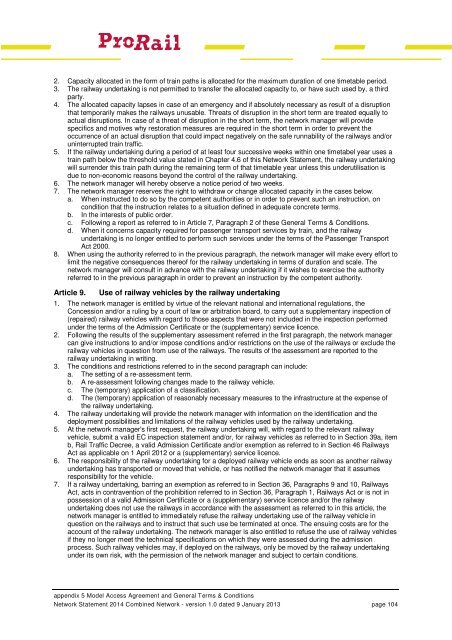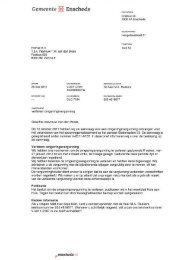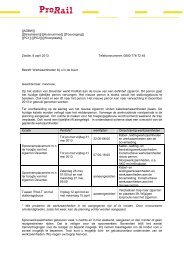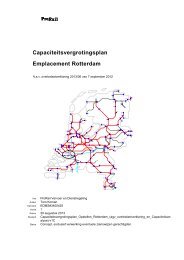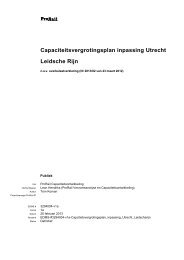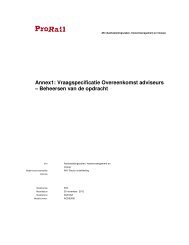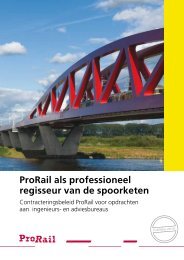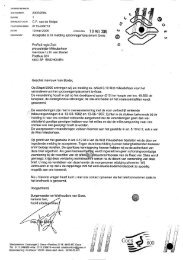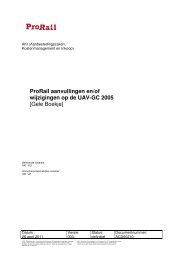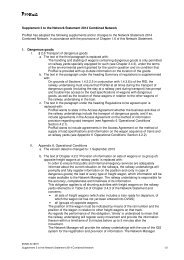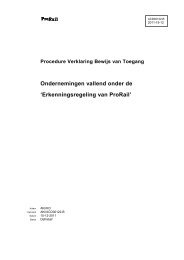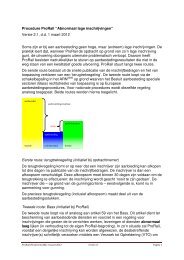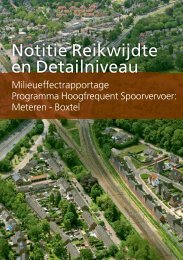Network Statement 2014 - ProRail
Network Statement 2014 - ProRail
Network Statement 2014 - ProRail
- No tags were found...
You also want an ePaper? Increase the reach of your titles
YUMPU automatically turns print PDFs into web optimized ePapers that Google loves.
2. Capacity allocated in the form of train paths is allocated for the maximum duration of one timetable period.3. The railway undertaking is not permitted to transfer the allocated capacity to, or have such used by, a thirdparty.4. The allocated capacity lapses in case of an emergency and if absolutely necessary as result of a disruptionthat temporarily makes the railways unusable. Threats of disruption in the short term are treated equally toactual disruptions. In case of a threat of disruption in the short term, the network manager will providespecifics and motives why restoration measures are required in the short term in order to prevent theoccurrence of an actual disruption that could impact negatively on the safe runnability of the railways and/oruninterrupted train traffic.5. If the railway undertaking during a period of at least four successive weeks within one timetabel year uses atrain path below the threshold value stated in Chapter 4.6 of this <strong>Network</strong> <strong>Statement</strong>, the railway undertakingwill surrender this train path during the remaining term of that timetable year unless this underutilisation isdue to non-economic reasons beyond the control of the railway undertaking.6. The network manager will hereby observe a notice period of two weeks.7. The network manager reserves the right to withdraw or change allocated capacity in the cases below.a. When instructed to do so by the competent authorities or in order to prevent such an instruction, oncondition that the instruction relates to a situation defined in adequate concrete terms.b. In the interests of public order.c. Following a report as referred to in Article 7, Paragraph 2 of these General Terms & Conditions.d. When it concerns capacity required for passenger transport services by train, and the railwayundertaking is no longer entitled to perform such services under the terms of the Passenger TransportAct 2000.8. When using the authority referred to in the previous paragraph, the network manager will make every effort tolimit the negative consequences thereof for the railway undertaking in terms of duration and scale. Thenetwork manager will consult in advance with the railway undertaking if it wishes to exercise the authorityreferred to in the previous paragraph in order to prevent an instruction by the competent authority.Article 9.Use of railway vehicles by the railway undertaking1. The network manager is entitled by virtue of the relevant national and international regulations, theConcession and/or a ruling by a court of law or arbitration board, to carry out a supplementary inspection of(repaired) railway vehicles with regard to those aspects that were not included in the inspection performedunder the terms of the Admission Certificate or the (supplementary) service licence.2. Following the results of the supplementary assessment referred in the first paragraph, the network managercan give instructions to and/or impose conditions and/or restrictions on the use of the railways or exclude therailway vehicles in question from use of the railways. The results of the assessment are reported to therailway undertaking in writing.3. The conditions and restrictions referred to in the second paragraph can include:a. The setting of a re-assessment term.b. A re-assessment following changes made to the railway vehicle.c. The (temporary) application of a classification.d. The (temporary) application of reasonably necessary measures to the infrastructure at the expense ofthe railway undertaking.4. The railway undertaking will provide the network manager with information on the identification and thedeployment possibilities and limitations of the railway vehicles used by the railway undertaking.5. At the network manager's first request, the railway undertaking will, with regard to the relevant railwayvehicle, submit a valid EC inspection statement and/or, for railway vehicles as referred to in Section 39a, itemb, Rail Traffic Decree, a valid Admission Certificate and/or exemption as referred to in Section 46 RailwaysAct as applicable on 1 April 2012 or a (supplementary) service licence.6. The responsibility of the railway undertaking for a deployed railway vehicle ends as soon as another railwayundertaking has transported or moved that vehicle, or has notified the network manager that it assumesresponsibility for the vehicle.7. If a railway undertaking, barring an exemption as referred to in Section 36, Paragraphs 9 and 10, RailwaysAct, acts in contravention of the prohibition referred to in Section 36, Paragraph 1, Railways Act or is not inpossession of a valid Admission Certificate or a (supplementary) service licence and/or the railwayundertaking does not use the railways in accordance with the assessment as referred to in this article, thenetwork manager is entitled to immediately refuse the railway undertaking use of the railway vehicle inquestion on the railways and to instruct that such use be terminated at once. The ensuing costs are for theaccount of the railway undertaking. The network manager is also entitled to refuse the use of railway vehiclesif they no longer meet the technical specifications on which they were assessed during the admissionprocess. Such railway vehicles may, if deployed on the railways, only be moved by the railway undertakingunder its own risk, with the permission of the network manager and subject to certain conditions.appendix 5 Model Access Agreement and General Terms & Conditions<strong>Network</strong> <strong>Statement</strong> <strong>2014</strong> Combined <strong>Network</strong> - version 1.0 dated 9 January 2013 page 104


